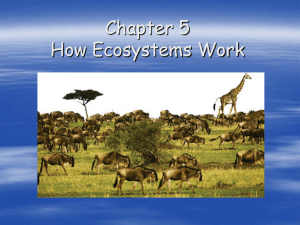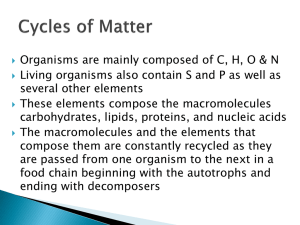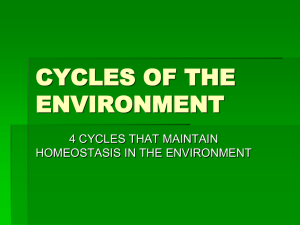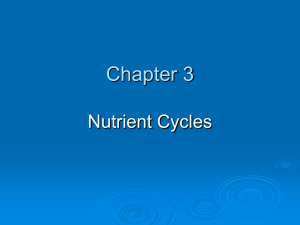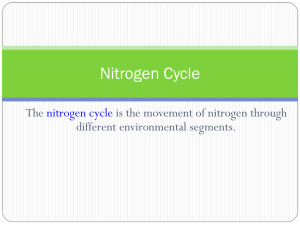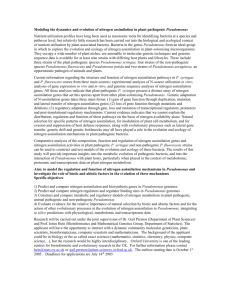The Nitrogen Cycle
advertisement
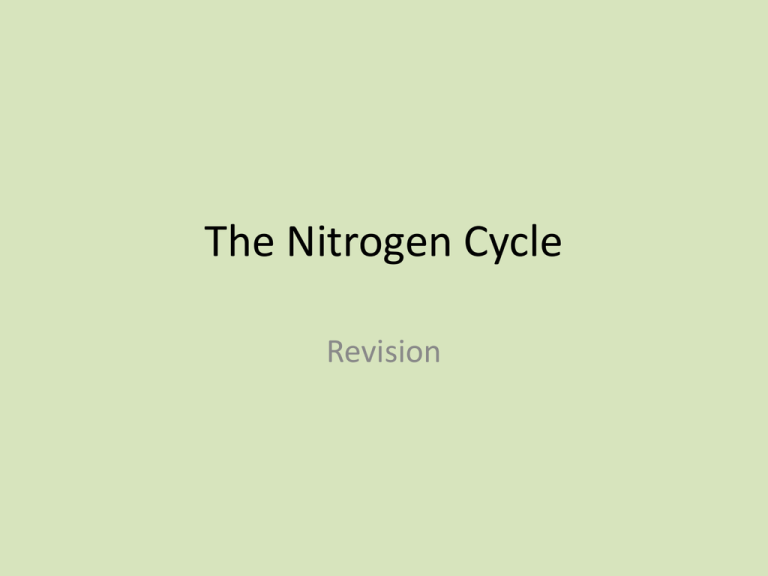
The Nitrogen Cycle Revision Learning Objectives • To understand that the Nitrogen Cycle is composed of the following processes: Nitrogen-Fixation Nitrification Assimilation (uptake) Ammonification Denitrificaton • To be able to use this information to answer exam questions where applied knowledge is required. Nutrient Cycling • Matter cycles between the non-living and living components of an ecosystem. CO2 SO2 N2 NH3 Producers H2O PO4 NON-LIVING COMPONENT Microbes C6H12O6 LIPIDS DNA PROTEINS LIVING COMPONENT • Simple, inorganic molecules are fixed from the environment by producers and microbes. • These are then built in to complex, organic molecules which are passed down the food chain. Nutrient Cycling • Eventually the complex, organic molecules are returned to the environment by decomposers. CO2 SO2 N2 NH3 Decomposers H2O PO4 NON-LIVING COMPONENT C6H12O6 LIPIDS DNA PROTEINS LIVING COMPONENT • This is where matter returns to the non-living component of the ecosystem. • Without producers, microbes and decomposers there would be no nutrient cycling and no life. The Nitrogen Cycle Nitrogen-Fixation • 78% of the atmosphere is nitrogen gas (N2). • The stable structure of nitrogen gas cannot be used as a source of nitrogen for growth. • The nitrogen in N2 is fixed into useful compounds by nitrogenfixing bacteria. • They reduce nitrogen gas to ammonia: N2 + 6H 2NH3 • The NH3 dissolves in soil water to form ammonium ions (NH4+). Nitrogen-Fixation (continued) • Nitrogen-fixing bacteria exist as free-living bacteria, but most live in colonies inside the root nodules of leguminous plants. Nitrogen-fixing bacteria living in root nodules is an example of mutualism, where both species benefit. • There are two other processes that fix nitrogen: The Haber Process N2 + 3H2 2NH3 N2 Lightning + 2O2 2NO2 Nitrification • A relatively simple process, nitrification converts ammonia into nitrate – which is a plants preferred form of nitrogen. • The process is carried out by nitrifying bacteria in two steps: NH4+ NO2ammonia nitrite ions NO2- NO3nitrite ions nitrate ions The ammonia that starts the nitrification process comes from: 1. Nitrogen-fixing bacteria 2. Haber process 3. Animal waste 4. Decomposition of dead organisms Assimilation • Plants require nitrogen in the form of dissolved nitrates NO3-. • Once the processes of nitrogen-fixation and nitrification have been carried out, plants are able to absorb NO3- by active transport. Absorbed nitrates are used to synthesise amino acids and nucleic acids. The uptake and incorporation of nitrogen into plant tissues is called assimilation. This nitrogen is now available to the rest of the food chain through feeding. Ammonification • When organisms die (and produce waste), microbial saprophytes release nitrogen locked in this material back to the environment. • More specifically, the proteins in detritus is broken down in two stages: Step 1: The saprophytes release enzymes which digest proteins into amino acids. Step 2: The amino group is removed from the amino acids, which then dissolves in soil to form NH4+ ions. Denitrification • Anaerobic bacteria called denitrifying bacteria are responsible for the constant loss of useful nitrogen from soil. NO3- N2 • The bacteria thrive in oxygen-poor, water-logged soil. • Denitrifying bacteria ‘complete the jigsaw’ of the nitrogen cycle. The Nitrogen Cycle Learning Objectives • To understand that the Nitrogen Cycle is composed of the following processes: Nitrogen-Fixation Nitrification Assimilation (uptake) Ammonification Denitrificaton • To be able to use this information to answer exam questions where applied knowledge is required.


